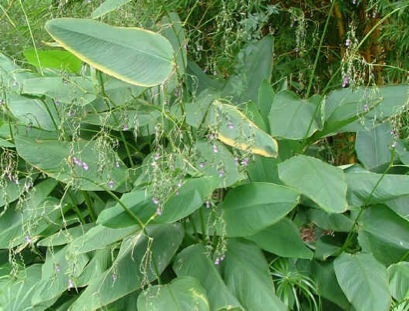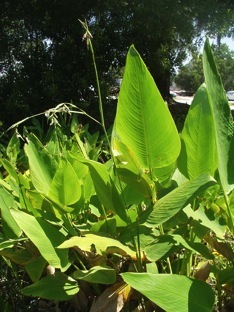
Large leaves of the Swamp Lilly used for cooking
Thalia geniculata: Swamp Wrap
You won’t find the “swamp lilly” in many foraging books. For a big plant it receives little attention.
Thalia geniculata (THAL-ee-yah gen-ik-yoo-LAH-tuh) comes from a good family, closely related to the gingers. It’s easy to identify, grows year round, and the forager has many uses for it. But several things conspire against the Swamp Lilly. First, its edible root turns pink when you cook it and tastes swampy. Not exactly the best asset to have, then again, not too many people are eating it. And as one of its other name implies, Alligator Flag, it likes to grow where alligators grow. That make collecting a tad more dangerous and limits its range. So what is the Swamp Lilly’s claim to fame? You can cook with its leaves.

Roots taste like swamp water
Most of our ancestors who foraged daily to stay alive didn’t have pots and pans. They would often wrap foods in leaves to cook them, and to keep them clean from the ashes. This was particularly true of any bread-like food. In fact “tamales” used to mean any food wrapped in leaves then cooked. While many foods can be cooked over a fire, cooking wrapped food in the embers extends the use of the fire and often allows the use of local spices.
Swamp Lilly leaves can grow up to eight inches wide and two and a half feet long (so catch a big fish.) They were also used to boil cornbread-like mixtures. Like the banana leaf and many others, the Swamp Lilly leaf can also be used to carry food. Young leaves are reportedly edible. I haven’t tried the leaves yet. When cooked the little roots resemble cooked shrimp, but not in flavor. They are swampy, just as alligator meat is swampy. Botanical researchers say Swamp Lilly was highly used during war times. The raw root does has medicinal uses from an antiseptic to a stimulant.
The Swamp Lilly, an appellation used in Panama, has many common names, including Alligator Flag, Red Flag and Fire Flag. It’s called a flag because alligator movements in the swamp makes the large leaf wave, showing the lizard’s location. Botanically, the Swamp Lilly is named after German physician Johannes Thal,(1542-83) though “thalia” has an allusion to the muse of the same name that presided over comedy. Geniculata means “many knees” and refers to the plant’s many jointed stems. Those stems are used for basket weaving in Africa. There are seven species in the genus, only a few like their feet wet.
Green Deane’s “Itemized” Plant Profile
IDENTIFICATION: A giant herb with a short root and many string-like roots, five to nine feet tall. Leaves long-stalked, lance shaped to oval, blunt point at apex, rounded a base, bright green, smooth. Flowers in pairs, rose-purple, dangling, fuzzy bracts, stems zigzag.
TIME OF YEAR: Year round
ENVIRONMENT: Swamps, ponds, lakes, low spots, sides of rivers.
METHOD OF PREPARATION: Young roots boiled, turning pink. Swampy flavor. Young leaves edible. Older leaves used for cooking other foods. To make the leaves easier to wrap with, wilt them by holding them close to the fire. The flowers and base of the stem are reported as edible cooked. I have not tired them yet.

